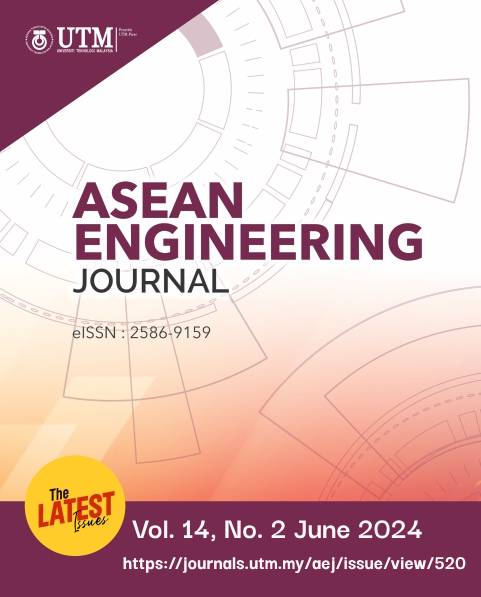WATER-RESPONSIVE SELF-HEALING MEMBRANE MODIFIED WITH POLYETHYLENEIMINE (PEI)/POLY (ACRYLIC ACID) (PAA)
DOI:
https://doi.org/10.11113/aej.v14.21341Keywords:
Intrinsic mechanism, water-responsive, self-healing, hydrogen bond, polyelectrolyteAbstract
The self-healing membrane has received substantial research attention in recent years due to its ability to overcome the difficulty in detecting the exact damage location of the membrane at a microscopic level. The healing effect of a self-healable membrane often requires the help of an external stimulus. This study reported the fabrication of a water-responsive self-healing membrane using polyethyleneimine (PEI)/poly(acrylic acid) (PAA) coated on polyethersulfone (PES) membrane via layer-by-layer (LbL) method. Fourier transform infrared spectroscopy (FTIR) and energy dispersive X-ray (EDX) were performed to observe the successful attachment of PEI and PAA onto the PES surface. The topographical analysis was performed using scanning electron microscopy (SEM) to visualize the healing performance. Apart from the instrumental analysis, pure water flux (PWF) was conducted to quantify the healing efficiency of the membrane. The best self-healing performance of the fabricated PEI/PAA self-healing membrane at 5.0 mg/mL concentration of PEI and PAA solutions displayed a healing efficiency of 70 % after being immersed into distilled water for 24 hours, compared to the concentrations of 1.0 mg/mL (19.8 %) and 3.0 mg/mL (34.3 %). This could be attributed to the higher amounts of PAA to form hydrogen bonds with surrounding water molecules, and subsequently promotes healing performance as hydrogen bonds are the basis for the self-healing process. This study proposes a newly develop water-stimulus PEI/PAA self-repairing membrane which contributes to the energy-efficient membrane filtration process.
References
M. Camara, N.R. Jamil, A.F. Bin Abdullah, 2019. Impact of land uses on water quality in Malaysia: a review, Ecological Processes. 8: 10. https://doi.org/10.1186/s13717-019-0164-x.
E.O. Ezugbe, S. Rathilal, 2020. Membrane technologies in wastewater treatment: A review, Membranes (Basel). 10 https://doi.org/10.3390/membranes10050089.
A. Nqombolo, A. Mpupa, R.M. Moutloali, P.N. Nomngongo, 2018. Wastewater Treatment Using Membrane Technology, in: Wastewater and Water Quality, InTech. https://doi.org/10.5772/intechopen.76624.
C.-H. Huang, Y.-L. Liu, 2017. Self-healing polymeric materials for membrane separation: an example of a polybenzimidazole-based membrane for pervaporation dehydration on isopropanol aqueous solution, RSC Adv. 7: 38360-38366. https://doi.org/10.1039/C7RA06644A
A. Surendran, S. Thomas, 2020. Self-healing polymeric systems-fundamentals, state of art, and challenges, in: Self-Healing Polymer-Based Systems, Elsevier. 1-16. https://doi.org/10.1016/b978-0-12-818450-9.00001-5.
S.J. Garcia, 2014. Effect of polymer architecture on the intrinsic self-healing character of polymers, European Polymer Journal. 53: 118 125. https://doi.org/10.1016/j.eurpolymj.2014.01.026.
M. Kazakli, G.A. Mutch, L. Qu, G. Triantafyllou, I.S. Metcalfe, 2020. Autonomous and intrinsic self-healing Al2O3 membrane employing highly-wetting and CO2-selective molten salts, Journal Membrane Science. 600. https://doi.org/10.1016/j.memsci.2020.117855.
M. Kosarli, D.G. Bekas, K. Tsirka, D. Baltzis, D.Τ. Vaimakis-Tsogkas, S. Orfanidis, G. Papavassiliou, A.S. Paipetis, 2019. Microcapsule-based self-healing materials: Healing efficiency and toughness reduction vs. capsule size, Composites Part B: Engineering. 171: 78 86. https://doi.org/10.1016/j.compositesb.2019.04.030.
K. Padhan, D. Mandal, 2020. Types of chemistries involved in self-healing polymeric systems, in: Self-Healing Polymer-Based Systems, Elsevier. 17-73. https://doi.org/10.1016/b978-0-12-818450-9.00002-7.
B.A. Getachew, S.R. Kim, J.H. Kim, 2017. Self-healing hydrogel pore-filled water filtration membranes, Environmental Science Technology. 51: 905-913. https://doi.org/10.1021/acs.est.6b04574.
A.F. Ismail, M.A. Rahman, M.H.D. Othman, T. Matsuura, 2019. Membrane Separation Principles and Applications, Elsevier. https://doi.org/10.1016/C2016-0-04031-7.
H. Chen, F. Cheng, C. Chen, H. Li, 2020. Study on self‐healing behavior of the layer‐by‐layer assembled polyethylenimine/poly (acrylic acid) film, Journal of Applied Polymer Science. 137: 49169. https://doi.org/10.1002/app.49169.
M. Humood, K. Polychronopoulou, Y. Song, J.C. Grunlan, A.A. Polycarpou, 2017. In situ nanomechanical behavior and self-healing response of polymeric multilayer thin films, Polymer. 131: 169 178. https://doi.org/10.1016/j.polymer.2017.10.036.
H. Tang, S. Ji, L. Gong, H. Guo, G. Zhang, 2013. Tubular ceramic-based multilayer separation membranes using spray layer-by-layer assembly, Polymer Chemistry. 4: 5621. https://doi.org/10.1039/c3py00617d.
L.-M. Petrila, F. Bucatariu, M. Mihai, C. Teodosiu, 2021. Polyelectrolyte Multilayers: An Overview on Fabrication, Properties, and Biomedical and Environmental Applications, Materials. 14: 4152. https://doi.org/10.3390/ma14154152.
Jucius, Lazauskas, Gudaitis, 2019. Multiple Hydrogen-Bonding Assisted Scratch-Healing of Transparent Coatings, Coatings. 9: 2796. https://doi.org/10.3390/coatings9120796.
















